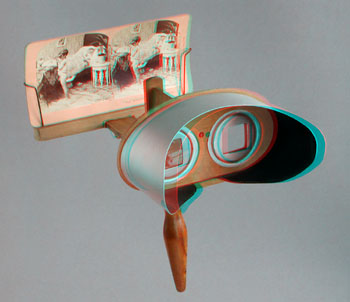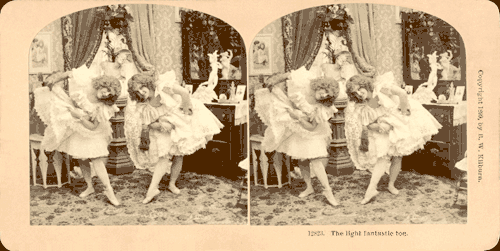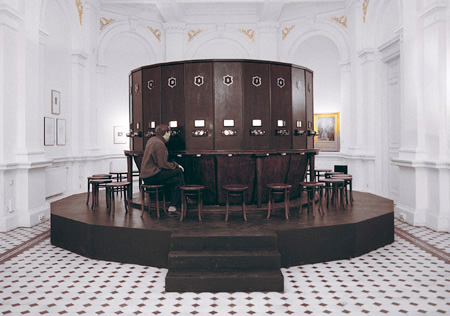
 The photosensitivity of silver salt was first discovered in the first half of the 18th century.
Almost one century later, in 1839, Louis Daguerre invented the daguerrotype – the first
practically applicable photographic technology. After a short period of enthusiasm the
disappointment occurred – the tiny, silver shimmering views were only to a limited degree
able to show the world as seen with both our eyes. Ten years later the British scientist,
Sir David Brewster, using and improving the Wheatstone stereoscope principle,
invented an appliance to view three-dimensional stereograms. A pair of photographs,
taken by a twin-lens camera with a distance between the lenses similar to the distance between human
eyes, gave an astonishing impression of the space, compensating the lack of natural colours to a certain degree. The stereoscopic photographs, first shown to the public at the London World Exhibition in 1851,
had been demonstrated to Queen Victoria and were warmly accepted.
The photosensitivity of silver salt was first discovered in the first half of the 18th century.
Almost one century later, in 1839, Louis Daguerre invented the daguerrotype – the first
practically applicable photographic technology. After a short period of enthusiasm the
disappointment occurred – the tiny, silver shimmering views were only to a limited degree
able to show the world as seen with both our eyes. Ten years later the British scientist,
Sir David Brewster, using and improving the Wheatstone stereoscope principle,
invented an appliance to view three-dimensional stereograms. A pair of photographs,
taken by a twin-lens camera with a distance between the lenses similar to the distance between human
eyes, gave an astonishing impression of the space, compensating the lack of natural colours to a certain degree. The stereoscopic photographs, first shown to the public at the London World Exhibition in 1851,
had been demonstrated to Queen Victoria and were warmly accepted.
 In 1871 the dry photographic plates with light-sensitive gelatine emulsion were invented. This released the photographers from the necessity to stay always near the darkroom. The relatively high photosensivity made it possible to take snapshots of moving targets. This was the beginning of the stormy development of photographic technology, including the stereoscopy. In the seventies and eighties of the 19th century in the United States and in many other countries numerous factories emerged, producing stereoscopic views in great quantities using the Oliver W. Holmes standard glued to 3,5 x 5 inch cardboards. The photographers, equipped with stereoscopic cameras, visited the most distant countries of the world, taking views of cities, picturesque landscapes, famous people, historical events, catastrophes and wonders of nature. The viewing appliances - stereoscopes - became an obligatory equipment of middle-class saloons.
In 1871 the dry photographic plates with light-sensitive gelatine emulsion were invented. This released the photographers from the necessity to stay always near the darkroom. The relatively high photosensivity made it possible to take snapshots of moving targets. This was the beginning of the stormy development of photographic technology, including the stereoscopy. In the seventies and eighties of the 19th century in the United States and in many other countries numerous factories emerged, producing stereoscopic views in great quantities using the Oliver W. Holmes standard glued to 3,5 x 5 inch cardboards. The photographers, equipped with stereoscopic cameras, visited the most distant countries of the world, taking views of cities, picturesque landscapes, famous people, historical events, catastrophes and wonders of nature. The viewing appliances - stereoscopes - became an obligatory equipment of middle-class saloons.
This Stereoscope was built after the
original Holmes Stereoscope. Oliver Wendell Holmes (1809-1894) has built 1861 – using
the principle of the Brewster's lens-and-prism Stereoscope – a simple, lightweight
and cheap appliance, suitable to watch the stereoscopic photographs glued to the 3,5x7 inch cardboard. Holmes – an American physicist, poet and writer – did not patent his invention.
Despite of this it was acknowledged as a world standard and remained unaltered more than half a
century without giving its inventor any material profits.
|
|
 |
 |
|
The stereoscopic image in Holmes format
from the Kilburn Brothers Factory in Littleton, New Hampshire, USA. This factory was established
in the eighties of the 19th century and had over 100 employees in its best period and survived till 1910. In this small town many similar factories competed against each another.
|
In the eighties of the 19th century the German inventor, August Fuhrmann,
constructed his „Kaiserpanorama“ (Emperor's Panorama) – known in some other countries as
„Photoplasticon“. It was a 10 feet diameter wooden drum with 25 stereoscopes on its perimeter
showing the backlit stereo slides simultaneously to 25 viewers.
Four of them still exist in Poland – two in Warsaw, one in Cracow and one in Poznan. | |  |
|
 The expansion of the stereoscopy ended in the beginning of the 20th century;
the invention of cinematography put an end to this expansion.
Nowadays the stereoscopy became just a hobby of several thousands amateurs,
who show their works in Internet-Circles
The expansion of the stereoscopy ended in the beginning of the 20th century;
the invention of cinematography put an end to this expansion.
Nowadays the stereoscopy became just a hobby of several thousands amateurs,
who show their works in Internet-Circles
 The ViewMaster viewers, which were very popular in the first years after World War II
(with round disks for seven 3D-pairs each) and different kind of gadgets,
decorated with three-dimensional views, are now totally forgotten.
Despite of this in Poland a print factory
The ViewMaster viewers, which were very popular in the first years after World War II
(with round disks for seven 3D-pairs each) and different kind of gadgets,
decorated with three-dimensional views, are now totally forgotten.
Despite of this in Poland a print factory  was newly established,
specialized in lenticular 3D prints, postcards, mouse pads, advertising prints etc.,
also producing simple stereoscopic viewers.
was newly established,
specialized in lenticular 3D prints, postcards, mouse pads, advertising prints etc.,
also producing simple stereoscopic viewers.
 Experiments in 3D cinematography started a long time ago. In Warsaw the 3D-cinema „Oka“
was opened in the early seventies, now a modern „IMAX“-cinema was built,
the next in Krakow, and the third in Katowice is still under construction.
Experiments in 3D cinematography started a long time ago. In Warsaw the 3D-cinema „Oka“
was opened in the early seventies, now a modern „IMAX“-cinema was built,
the next in Krakow, and the third in Katowice is still under construction.
 And that's all about the history of stereoscopy. And what about the Third Dimension nowadays?
Of the millions of stereoscopic views of the last century only thousands still remained,
many amateurs are collecting these documents of history, customs and fashion.
In our gallery you find 40 views from the end of the 19th and the beginning of 20th
century. Because the viewing of the original twin views requires special appliances
or eye-acrobatics, these views are digitally converted to anaglyphs for viewing with
simple red
And that's all about the history of stereoscopy. And what about the Third Dimension nowadays?
Of the millions of stereoscopic views of the last century only thousands still remained,
many amateurs are collecting these documents of history, customs and fashion.
In our gallery you find 40 views from the end of the 19th and the beginning of 20th
century. Because the viewing of the original twin views requires special appliances
or eye-acrobatics, these views are digitally converted to anaglyphs for viewing with
simple red blue
glasses
blue
glasses  Click on the thumbnail to see the view in full size.
Another click brings you back to the Gallery.
More about anaglyphs:
Click on the thumbnail to see the view in full size.
Another click brings you back to the Gallery.
More about anaglyphs: 
 You can find inexpensive anaglyph glasses in stationery shops
or on the Internet:
You can find inexpensive anaglyph glasses in stationery shops
or on the Internet:  More about the Photoplasticons in Warsaw
More about the Photoplasticons in Warsaw  and in Pozna˝
and in Pozna˝  Remarks, inquiries:
Remarks, inquiries: 
Thanks to Mrs. Christina Bartsch






 The photosensitivity of silver salt was first discovered in the first half of the 18th century.
Almost one century later, in 1839, Louis Daguerre invented the daguerrotype – the first
practically applicable photographic technology. After a short period of enthusiasm the
disappointment occurred – the tiny, silver shimmering views were only to a limited degree
able to show the world as seen with both our eyes. Ten years later the British scientist,
Sir David Brewster, using and improving the Wheatstone stereoscope principle,
invented an appliance to view three-dimensional stereograms. A pair of photographs,
taken by a twin-lens camera with a distance between the lenses similar to the distance between human
eyes, gave an astonishing impression of the space, compensating the lack of natural colours to a certain degree. The stereoscopic photographs, first shown to the public at the London World Exhibition in 1851,
had been demonstrated to Queen Victoria and were warmly accepted.
The photosensitivity of silver salt was first discovered in the first half of the 18th century.
Almost one century later, in 1839, Louis Daguerre invented the daguerrotype – the first
practically applicable photographic technology. After a short period of enthusiasm the
disappointment occurred – the tiny, silver shimmering views were only to a limited degree
able to show the world as seen with both our eyes. Ten years later the British scientist,
Sir David Brewster, using and improving the Wheatstone stereoscope principle,
invented an appliance to view three-dimensional stereograms. A pair of photographs,
taken by a twin-lens camera with a distance between the lenses similar to the distance between human
eyes, gave an astonishing impression of the space, compensating the lack of natural colours to a certain degree. The stereoscopic photographs, first shown to the public at the London World Exhibition in 1851,
had been demonstrated to Queen Victoria and were warmly accepted.
 In 1871 the dry photographic plates with light-sensitive gelatine emulsion were invented. This released the photographers from the necessity to stay always near the darkroom. The relatively high photosensivity made it possible to take snapshots of moving targets. This was the beginning of the stormy development of photographic technology, including the stereoscopy. In the seventies and eighties of the 19th century in the United States and in many other countries numerous factories emerged, producing stereoscopic views in great quantities using the Oliver W. Holmes standard glued to 3,5 x 5 inch cardboards. The photographers, equipped with stereoscopic cameras, visited the most distant countries of the world, taking views of cities, picturesque landscapes, famous people, historical events, catastrophes and wonders of nature. The viewing appliances - stereoscopes - became an obligatory equipment of middle-class saloons.
In 1871 the dry photographic plates with light-sensitive gelatine emulsion were invented. This released the photographers from the necessity to stay always near the darkroom. The relatively high photosensivity made it possible to take snapshots of moving targets. This was the beginning of the stormy development of photographic technology, including the stereoscopy. In the seventies and eighties of the 19th century in the United States and in many other countries numerous factories emerged, producing stereoscopic views in great quantities using the Oliver W. Holmes standard glued to 3,5 x 5 inch cardboards. The photographers, equipped with stereoscopic cameras, visited the most distant countries of the world, taking views of cities, picturesque landscapes, famous people, historical events, catastrophes and wonders of nature. The viewing appliances - stereoscopes - became an obligatory equipment of middle-class saloons.



 The expansion of the stereoscopy ended in the beginning of the 20th century;
the invention of cinematography put an end to this expansion.
Nowadays the stereoscopy became just a hobby of several thousands amateurs,
who show their works in Internet-Circles
The expansion of the stereoscopy ended in the beginning of the 20th century;
the invention of cinematography put an end to this expansion.
Nowadays the stereoscopy became just a hobby of several thousands amateurs,
who show their works in Internet-Circles
 The ViewMaster viewers, which were very popular in the first years after World War II
(with round disks for seven 3D-pairs each) and different kind of gadgets,
decorated with three-dimensional views, are now totally forgotten.
Despite of this in Poland a print factory
The ViewMaster viewers, which were very popular in the first years after World War II
(with round disks for seven 3D-pairs each) and different kind of gadgets,
decorated with three-dimensional views, are now totally forgotten.
Despite of this in Poland a print factory  was newly established,
specialized in lenticular 3D prints, postcards, mouse pads, advertising prints etc.,
also producing simple stereoscopic viewers.
was newly established,
specialized in lenticular 3D prints, postcards, mouse pads, advertising prints etc.,
also producing simple stereoscopic viewers.
 Experiments in 3D cinematography started a long time ago. In Warsaw the 3D-cinema „Oka“
was opened in the early seventies, now a modern „IMAX“-cinema was built,
the next in Krakow, and the third in Katowice is still under construction.
Experiments in 3D cinematography started a long time ago. In Warsaw the 3D-cinema „Oka“
was opened in the early seventies, now a modern „IMAX“-cinema was built,
the next in Krakow, and the third in Katowice is still under construction. And that's all about the history of stereoscopy. And what about the Third Dimension nowadays?
Of the millions of stereoscopic views of the last century only thousands still remained,
many amateurs are collecting these documents of history, customs and fashion.
In our gallery you find 40 views from the end of the 19th and the beginning of 20th
century. Because the viewing of the original twin views requires special appliances
or eye-acrobatics, these views are digitally converted to anaglyphs for viewing with
simple red
And that's all about the history of stereoscopy. And what about the Third Dimension nowadays?
Of the millions of stereoscopic views of the last century only thousands still remained,
many amateurs are collecting these documents of history, customs and fashion.
In our gallery you find 40 views from the end of the 19th and the beginning of 20th
century. Because the viewing of the original twin views requires special appliances
or eye-acrobatics, these views are digitally converted to anaglyphs for viewing with
simple red![]() blue
glasses
blue
glasses  Click on the thumbnail to see the view in full size.
Another click brings you back to the Gallery.
More about anaglyphs:
Click on the thumbnail to see the view in full size.
Another click brings you back to the Gallery.
More about anaglyphs: 
 You can find inexpensive anaglyph glasses in stationery shops
or on the Internet:
You can find inexpensive anaglyph glasses in stationery shops
or on the Internet:  More about the Photoplasticons in Warsaw
More about the Photoplasticons in Warsaw  and in Pozna˝
and in Pozna˝  Remarks,
Remarks, ![]()



